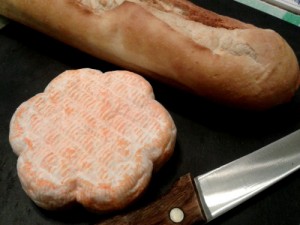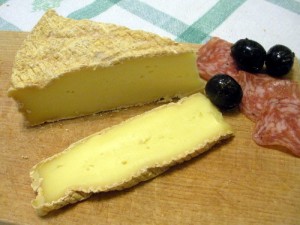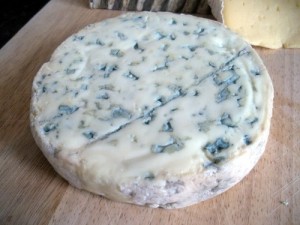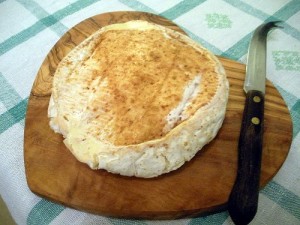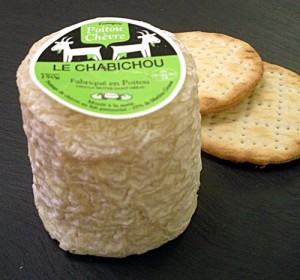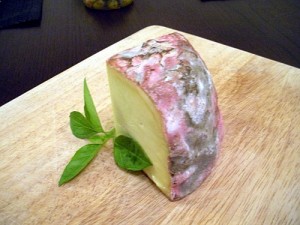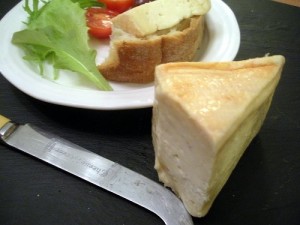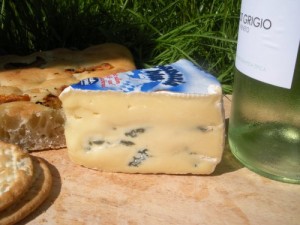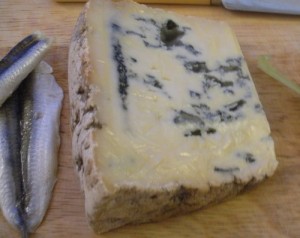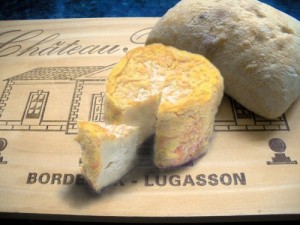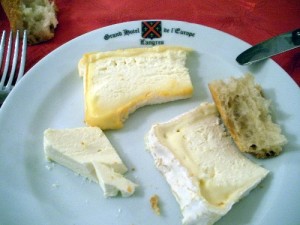Archive for the ‘Semi-soft’ Category
St. Albray
March 31st, 2019 Posted 7:06 pm
This is one of the first cheeses we ever reviewed. However, we weren’t taking photos at this point. Nearly nine years later, we found some for sale in a visiting French market.
Many years ago, we decided to start taking notes about the various cheeses we had tried. This was one of a handful of cheeses included in that first week’s record. We recorded it as “Petit Tourtain”. Four months later, we reviewed it again under the name “St. Albray”, completely unaware that it was, in fact, the same cheese.
To be honest, we’re still slightly confused about the naming of the cheese. It is understood that St. Albray is the recognised name of the cheese. Normally, it is made in a large 1½Kg form, with the smaller (200g) version being referred to as “petit”. Seeing as the cheese is not protected by AOC status, it is entirely possible that other cheesemakers around France are producing bootleg versions.
The first thing we notice about the cheese is it’s six lobed flower shape. The rind is a pinky / orange colour dusted with white.
The pate is a pale cream colour, soft, slightly rubbery with a waxy texture. It has almost no smell at all.
The taste is very delicate, slightly salty, bittering slightly closer to the rind.
In summary, it’s not a very exciting cheese. The best things about it are the texture and the fact that it’s pretty. It would make a good addition to a cheeseboard for non-cheeselovers.
We have reviewed this cheese three times now, and our opinion hasn’t changed.
Reviewed by Nick & Olympia, 2010 & 2019




 (1.5/5)
(1.5/5)
Posted in 1 Star - Meh, Cow's milk, French, Semi-soft, Washed
Milleens
February 3rd, 2019 Posted 6:41 pm
Now there’s a cheese that looks like a proper rustic, traditional farmhouse cheese that has been made for many generations. It is however, a relatively modern creation, first produced in 1976.
From the rugged, but lush Atlantic coast of the furthest south western corner of Ireland. The Beara Peninsular, County Cork, is home to the herd of Friesian cows that provide the milk for this cheese, giving it almost alpine like qualities.
On the outside, its course orangey, light brown rind smells somewhat like a Parisian concrete pissoir: earthy with an overpowering ammonia content.
The pate, is rubbery, soft and yielding, with a waxy feel and look. The smell is pleasantly milky with no trace of the ammonia that so dominates the rind.
The smooth, waxy texture has a mild, slight bitter edge at first bite, that quickly fades, revealing a subtle Morbier like herbaceous, alpine flavour with vague, but elusive hints of caramel that you’re never really certain were there.
All in all, it’s a good cheese. Pleasant, but not terribly exciting.
Manufactured by Milleens Cheese Ltd.
Purchased from Cheesology
Reviewed by Nick and Olympia, 2018




 (3/5)
(3/5)
Posted in 3 Stars - Good, Cow's milk, Irish, Semi-soft, Washed
Fourme d’Ambert
January 29th, 2017 Posted 6:48 pm
Fourme d’Ambert is one of the oldest known cheeses, dating back to the Roman occupation of France, around 2,000 years ago. The recipe, that is, not the actual cheese which is normally only aged for a month or two.
Traditionally made in a cylindrical “fourme” (French Auvergnat dialect for mould) about 5½” (13cm) diameter and 7½” (19cm) tall, the wheel is unusually tall for its diameter. Usually, it is sold in slices across the wheel rather than wedges.
Soft and yielding, almost spreadable, dusted in a white/grey mould. The pate is off white to dark cream (depending upon age) and flecked with greenish blue. It’s a delightfully appealing cheese from the offset.
The smell is slight, almost non-existent. The texture is deliciously smooth and creamy, yielding pleasantly in the mouth. The flavour likewise is smooth and creamy, delicate with hints of blue. It could be described as similar to a very mellow Roquefort, not so sharp and a lot less salty.
It is a generally pleasant cheese, inoffensive and well behaved. A perfect blue addition to the cheeseboard when you might not want to overwhelm your guests.
Easily available from many supermarkets.
Reviewed by Nick & Olympia, 2011.




 (4/5)
(4/5)
Posted in 4 Stars - Very Good, Blue, Cow's milk, French, Semi-soft
Voluptueuse Aphrodite
October 12th, 2014 Posted 9:44 pm
We were quite excited to received this gift from some friends, when they returned from a trip to France. It is washed in Calvados and dusted with ginger (to give it an aphrodisiac effect, apparently). Oozing and collapsing under its own decadence, it promised much and we could barely wait for our Sunday cheese fest to try it.
Looks fantastic, doesn’t it?
It has a mild smell that is slightly cheesy, but nothing more. The pate is soft and gooey around the edges, but firm in the middle.
The flavour is initially sharp, especially in the firmer centre, with a slight bitterness. Sadly, we detected no hint of Calvados nor ginger, which was actually rather disappointing.
A voluptuous goddess of love!…Washed in Calvados!… Dusted in ginger!… One expects it to be exciting… provocative sensuality, velvety smooth, with an intoxicating richness and a little touch of spice. This was very much a plain Jane.
As for the aphrodisiac effects, we didn’t experience any sudden urges to drag one another to the bedroom and rip each others clothes off.
…so, it seems looks can also be deceiving in the world of cheese.
It did get better with age, becoming more like a Camembert, but still far from expectation.
All in all it wasn’t a bad cheese. A shame really, it promised so much, but failed to live up to its name.
Reviewed by Nick & Olympia, 2013




 (3/5)
(3/5)
Posted in 3 Stars - Good, Cow's milk, French, Semi-soft, Washed
Le Chabichou du Poitou
August 3rd, 2014 Posted 7:50 pm
| Wrinkly and dusted with a white bloom, a two inch tall, slightly conical drum, this little cheese comes from around Poitiers. Apparently, it dates back to the Moorish invasion of that area in 732. Some Arabs stayed behind, and with them, their herds of goats… and, well, this was France, so they simply had to make cheese from the milk.
This is classified as an aged fresh cheese (see the Glossary for an explanation) and is typically 2-3 weeks old when ready. Unusually for a goat’s cheese, it only has a faint whiff of goat. It does however have a strong smell, that can only be described as mousey. Sweet, pungent… and, well… like mouse pee. The interior has a soft, thin buttery layer whilst the inner pate is quite firm, like slightly dried out putty. Once cut, there is a very strong goaty smell. The taste starts very fresh and sharp and contains concentrated essence of goat, then it turns quite bitter, leaving a lingering and slightly burning aftertaste. Olympia loves goat’s cheese and loved this, I wasn’t quite so keen (hence the middle of the road score). |
Very goaty, so if you like goat’s cheese, you will probably enjoy this.
Purchased from the French cheese stall outside Brighton Station,
Reviewed by Nick & Olympia, 2012




 (2.5/5)
(2.5/5)
Posted in 2 Stars - OK, French, Goat's milk, Semi-soft
Francis
April 6th, 2014 Posted 8:13 pm
| What’s pink and fluffy, but isn’t pink fluff? That’s right… cheese, a cheese called Francis.
This cheese was named Francis in honour of the famous British cheesemaker James Aldridge, who’s name wasn’t James at all, but actually Francis. It was developed by another James (James McCall) who was in James’ (Francis) employ when he was a teenager. James (not Francis) is now a fully fledged cheesemaker and has his own company (James’s Cheese). Although the cheese itself is made by James Martin at Lyburn Farm. So, in summary: James makes James’ of James’s cheese Francis, named after his ex-boss Francis aka. James. – Oh, it’s so confusing Right, now we’ve got that all sorted, the important bit: Covered in dust pink, grey and white moulds. Francis is washed in the same culture that is used to wash Livarot and Munster. As a result, it smells very like them, strong and pungent. Initially, the flavour is also strong, but in some strange way, not strong, becoming mellow, but with a definite presence. The texture is soft and malleable, but with an unexpected chalkiness. Its flavour is like that of its French cousins, but at the same time not. Like the history of its creation, it is confusing and complex. |
Produced by Lyburn Farm
Purchased from Sturminster Newton Cheese Festival 2013
Reviewed by Nick & Olympia, 2013




 (3.5/5)
(3.5/5)
Posted in 3 Stars - Good, Cow's milk, English, Semi-soft, Washed
Maroilles
January 19th, 2014 Posted 7:17 pm
| From a Trappist recipe, over 1,000 years old, this distinctive sticky, orange slab is the favourite of kings, and it’s not hard to see why.
It has an attractive orange rind. But… it’s not coloured with an annatto stained wash like many other orangey coloured cheeses. This is the colour the the particular strain of bacteria that is grown on its surface. As it matures, Maroilles is repeatedly turned and washed with brine. This kills off the usual white moulds, allowing a culture of orange bacteria to develop, giving it a sticky, oily texture. It has an acrid smell, that is quite pungent, but not strong. Inside, the paste is also quite sticky and oily. A pale yellow in colour with little holes and a soft, rubbery bite. The flavour is initially, not strong, but again, distinctly acrid and slightly bitter. However, the flavour increases as you chew. Strangely, the aftertaste is stronger still. The bitter aftertaste fades and is replaced with sweet buttermilkiness. In some ways, it has a strong flavour, yet it is mild. All in all, it provides a complex tasting experience that is rather hard to describe. |
Purchased from the French cheese stall, Brighton station.
Reviewed by Nick & Olympia, 2012




 (3/5)
(3/5)
Posted in 3 Stars - Good, Cow's milk, French, Semi-soft, Washed
Bavaria Blu
December 8th, 2013 Posted 8:47 pm
Sometimes sold under the name of Cambazola or Blue Brie, this pleasant little cheese that is easily available in many supermarkets. Though the alternative names suggest it could be Italian or French, it is actually German.
It is, by all accounts a blue Brie, using the same recipe as ordinary Brie. However, introducing the blue moulds is somewhat unconventional. Normally, the mould culture is added to the milk. During maturation, and starved of oxygen, it lies dormant until stainless steel wires are used to puncture the rind. With Bavaria Blu, the mould culture is introduced during maturation by injecting it directly into the cheese. This causes the blue moulds to be localised into little pockets rather than veins that pervade the paste.
Coated with a soft, dusty, edible, white rind. It has a cream to white paste, mottled with blue splodges, making it a quite attractive looking cheese.
Like a Brie, it has little or no smell, but unlike Brie it doesn’t produce a smell of ammonia when it gets really ripe.
It has a soft creamy texture, interspersed with the slightly harder patches of blue. A soft, delicate Brie like flavour with a gently blueness. As blue cheeses go, it is very inoffensive. A blue cheese for people that don’t like blue cheese.
Purchased from most leading supermarkets.
Produced by various manufacturers including: Cambazola, Bergader & Edelweiß
Reviewed by Nick & Olympia 2012




 (3/5)
(3/5)
Posted in 3 Stars - Good, Blue, Cow's milk, German, Semi-soft
Binham Blue
August 4th, 2013 Posted 4:20 pm
Soft creamy yellow with starkly contrasting deep green/blue veins, a gnarled rind dusted in white moulds. This looks just like a blue cheese ought to.
The paste is soft and yields under pressure, but not quite enough to spread.
It has a very mild creamy taste, with bitter overtones, but not in the least bit sharp, like so many other blue cheeses. Other than that, there is little to say. It’s OK… a blue cheese for people that don’t like blue cheese.
It looks fantastic, and creates an anticipatory expectation that, sadly, fails to be met.
Purchased from Larners, Holt.
Reviewed by Nick & Olympia 2012




 (2/5)
(2/5)
Posted in 2 Stars - OK, Blue, Cow's milk, English, Semi-soft
Langres
July 7th, 2013 Posted 5:22 pm
This rather smelly, but delightful cheese is made in the Champagne region of France in the town of the same name. Bright yellow/orange, sticky, wrinkly and sunken in the middle, Langres looks like a deflated alien brain.
About 3″ in diameter, and washed in Champagne mixed with annatto, to give it the orange rind, Langres is quite a smelly little cheese, slightly sweet, pungent but not stinky.
Then dent in the top is apparently due to the fact that it is only turned twice during maturation. As the whey and wash drains through the cheese, causing the top collapses in. Some aficionados will pour wine, Champagne or spirits into this dent before serving.
In younger cheeses, the paste is quite firm, but it starts to go gooey around the edges as it matures. Ideally, it is about right when this process has reached about half way (about 1cm). The flavour is complex, there’s a fresh sharpness that makes way to a much mellower and satisfying flavour that has a great deal of character. Eaten with a sip of wine, brings out a floral quality.
Purchased from Selfridges, London
Reviewed by Nick & Olympia 2010




 (4/5)
(4/5)
We originally reviewed this cheese in 2010, but on a recent trip to France spent a day in Langres. Of course we had to try this cheese in its home town, although avoiding it would have been difficult. In this town, it seems that everything is either cooked or served with Langres.
Top: Langres – Bottom left: Langres fraiche – Bottom right: Chaource
We discovered that the Langres cheese is also eaten fresh. It is pleasant enough, but tastes very much like any other fresh cheese. So, we’re glad that they drown it in booze and let it fester for a couple of months.
Posted in 4 Stars - Very Good, Cow's milk, French, Semi-soft, Washed

